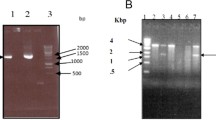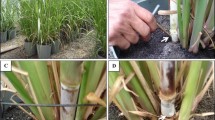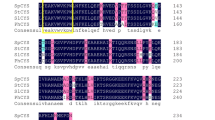Abstract
Corn cystatin (CC), a phytocystatin, shows a wide inhibitory spectrum against various cysteine proteinases. We produced transgenic rice plants by introducing CC cDNA under CaMV 35S promoter as a first step to obtain a rice plant with insecticidal activity. This attempt was based on the observation that many insect pests, especially Coleoptera, have cysteine proteinases, probably digestive enzymes, and also that oryzacystatin, an intrinsic rice cystatin, shows a narrow inhibition spectrum and is present in ordinary rice seeds in insufficient amounts to inhibit the cysteine proteinases of rice insect pests. The transgenic rice plants generated contained high levels of CC mRNA and CC protein in both seeds and leaves, the CC protein content of the seed reaching ca. 2% of the total heat soluble protein. We also recovered CC activity from seeds and found that the CC fraction efficiently inhibited both papain and cathepsin H, whereas the corresponding fraction from non-transformed rice seeds showed much lower or undetectable inhibitory activities against these cysteine proteinases. Furthermore, CC prepared from transgenic rice plants showed potent inhibitory activity against proteinases that occur in the gut of the insect pest, Sitophilus zeamais.
Similar content being viewed by others
References
Abe K, Emori Y, Kondo H, Suzuki K, Arai S: Molecular cloning of a cysteine proteinase inhibitor of rice (oryzacystatin). J Biol Chem 262: 16793–16797 (1987).
Abe K, Kondo H, Arai S: Purification and characterization of a rice cysteine proteinase inhibitor. Agric Biol Chem 51: 2763–2768 (1987).
Abe K, Emori Y, Kondo H, Arai S, Suzuki K: The NH2-terminal 21 amino acid residues are not essential for the papain-inhibitory activity of oryzacystatin, a member of the cystatin superfamily. J Biol Chem 263: 7655–7659 (1988).
Abe M, Abe K, Kuroda M, Arai S: Corn kernel cysteine proteinase inhibitor as a novel cystatin superfamily member of plant origin: molecular cloning and expression studies. Eur J Biochem 209: 933–937 (1992).
Abe M, Abe K, Iwabuchi K, Domoto C, Arai S: Corn cystatin I expressed in Escherichia coli: investigation of its inhibitory profile and occurrence in corn kernels. J Biochem 116: 488–492 (1994).
Barrett AJ, Kirschke H: Cathepsin B, cathepsin H, and cathepsin L. Meth Enzymol 80: 535–561 (1981).
Chen MS, Johnson B, Wen L, Muthukrishnan S, Kramer KJ, Morgan TD, Reeck GR: Rice cystatin: bacterial expression, purification, cysteine proteinase inhibitory activity, and insect growth suppressing activity of a truncated form of the protein. Prot Purif Express 3: 41–49 (1992).
Finnegan J., McElroy D: Transgene inactivation; plants fight back. Bio/Technol 12: 883–887 (1994).
Fujimaki M, Abe M, Arai S: Degradation of zein during germination of corn Agric Biol Chem 41: 887–891 (1977).
Gritz L, Davies J: Plasmid-encoded hygromycin B resistance: the sequence of hygromycin B phosphotransferase gene and its expression in Escherichia coli and Saccharomyces cerevisiae. Gene 25: 179–188 (1983).
Hayakawa T, Zhu Y, Itoh K, Kimura Y, Izawa T, Shimamoto K, Toriyama S: Genetically engineered rice resistant to rice stripe virus, an insect-transmitted virus. Proc Natl Acad Sci USA 89: 9865–9869 (1992).
Hosoyama H, Irie K, Abe K, Arai S: Introduction of a chimeric gene encoding an oryzacystatin-β-glucuronidase fusion protein into rice protoplasts and regeneration of transformed plants. Plant Cell Rep, in press.
Hosoyama H, Irie K, Abe K, Arai S: Oryzacystatin exogenously introduced into protoplasts and regeneration of transgenic rice. Biosci Biotechnol Biochem 58: 1500–1506 (1992).
Hsu S-M, Raine L, Fanger H: Use of avidin-biotin-peroxidase complex (ABC) in immunoperoxidase techniques: a comparison between ABC and unlabeled antibody (PAP) procedures. J Histochem Cytochem 29: 577–580 (1981).
Kondo H, Emori Y, Abe K, Suzuki K, Arai S: Cloning and sequence analysis of the genomic DNA fragment encoding oryzacystatin. Gene 81: 259–265 (1989).
Kondo H, Abe K, Arai S: Immunoassay of oryzacystatin occurring in rice seeds during maturation and germination. Agric Biol Chem 53: 2949–2954 (1989).
Kondo H, Abe K, Nishimura I, Watanabe H, Emori Y, Arai S: Two distinct cystatin species in rice seeds with different specificities against cysteine proteinases: molecular cloning, expression, and biochemical studies on oryzacystatin II. J Biol Chem 265: 15832–15837 (1990).
Kuroda M, Ishimoto M, Suzuku K, Kondo H, Abe K, Kitamura K, Arai S: Oryzacystatin exhibit growth-inhibitory and lethal effects on different species of bean insect pests, Collosobruchus chinensis (Coleoptera) and Riptortus clavatus (Hemiptera). Biosci Biotechnol Biochem, in press.
Laemmli UK: Cleavage of structural proteins during the assembly of the head of bacteriophage T4. Nature 227: 680–685 (1970).
Liang C, Brookhart G, Feng GH, Reeck GR, Kramer KJ: Inhibition of digestive proteinases of stored grain Coleoptera by oryzacystatin, a cysteine proteinase inhibitor from rice seed. FEBS Lett 278: 139–142 (1991).
Maniatis T, Fritsch EF, Sambrook J: Molecular Cloning: A Laboratory Manual. Cold Spring Harbor Laboratory Press, Cold Spring Harbor, NY (1982).
Matsumoto I, Watanabe H, Abe K, Arai S, Emori Y: A putative digestive cysteine proteinase of an insect, Drosophila melanogaster, predominantly expressed in embryonic and larval midgut. Eur J Biol 227: 582–587 (1995).
Norman MR, Houseman JG: Identification of cathepsin B, D and H in the larval midgut of colorado potato beetle, Leptinotarsa decemlineata (colleoptera: chrysomelidae). Insect Biochem 171: 377–381 (1990).
Simamoto K, Terada R, Izawa T, Fujimoto H: Fertile transgenic rice plants regenerated from transformed protoplasts. Nature 338: 274–276 (1989).
Terada R, Shimamoto K: Expression of CaMV 33S-GUS gene in transgenic rice plants. Mol Gen Genet 220: 389–392 (1990).
Watanabe H, Abe K, Emori Y, Hosoyama H, Arai S: Molecular cloning and gibberellin-induced expression of multiple cysteine proteinases of rice seeds (oryzasins). J Biol Chem 266: 16897–16902 (1991).
Zhang W, McElroy D, Wu R: Analysis of rice Actl 5′ region activity in transgenic rice plants. Plant Cell 3: 1155–1165 (1991).
Author information
Authors and Affiliations
Rights and permissions
About this article
Cite this article
Irie, K., Hosoyama, H., Takeuchi, T. et al. Transgenic rice established to express corn cystatin exhibits strong inhibitory activity against insect gut proteinases. Plant Mol Biol 30, 149–157 (1996). https://doi.org/10.1007/BF00017809
Received:
Accepted:
Issue Date:
DOI: https://doi.org/10.1007/BF00017809




